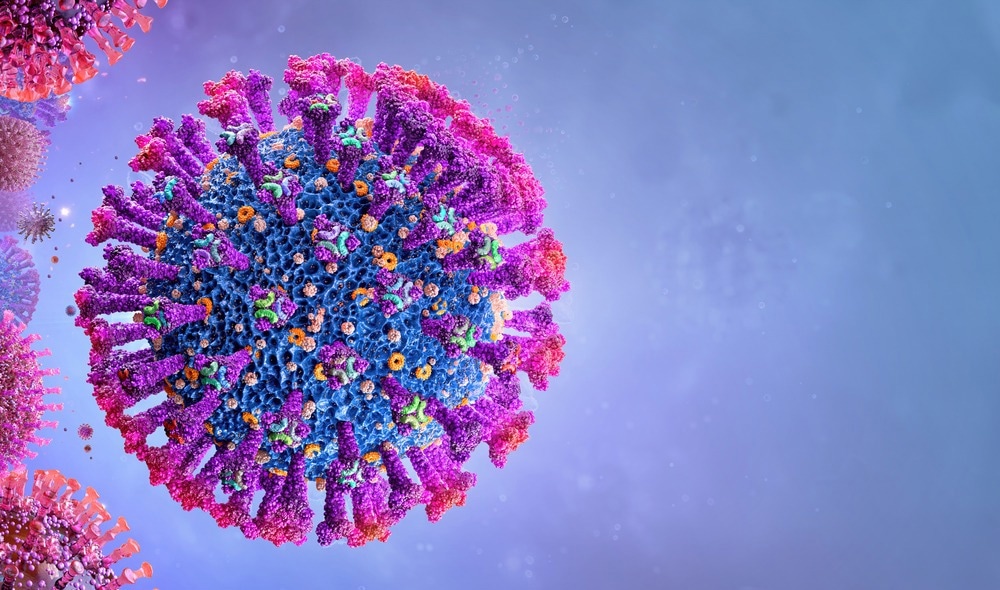 By Neha MathurReviewed by Danielle Ellis, B.Sc.Feb 13 2023
By Neha MathurReviewed by Danielle Ellis, B.Sc.Feb 13 2023In a recent study published in the PLOS Biology, researchers found that leucine-rich repeat-containing protein 15 (LRRC15), a toll-like receptor (TLR)-related cell surface receptor, blocked severe acute respiratory syndrome coronavirus 2 (SARS-CoV-2) spike (S) binding.
 Study: Fibroblast-expressed LRRC15 is a receptor for SARS-CoV-2 spike and controls antiviral and antifibrotic transcriptional programs. Image Credit: Corona Borealis Studio/Shutterstock
Study: Fibroblast-expressed LRRC15 is a receptor for SARS-CoV-2 spike and controls antiviral and antifibrotic transcriptional programs. Image Credit: Corona Borealis Studio/Shutterstock
Background
LRRC15 is expressed primarily in innate-immune barriers, including the placenta, skin, and lymphatic tissues. However, human collagen-producing lung myofibroblasts during severe coronavirus disease 2019 (COVID-19) (a perturbed state) also express the messenger ribonucleic acid (mRNA) for LRRC15 protein, and it lines their airways. The current study showed that these fibroblasts suppress both pseudotyped and authentic SARS-CoV-2 infection in trans.
Angiotensin-converting enzyme 2 (ACE2) is the primary entry receptor for SARS-CoV-2 S glycoprotein. However, studies have not yet identified other host factors that promote SARS-CoV-2 S binding.
About the study
In the present study, researchers used an unbiased functional genomics approach called whole-genome Clustered Regularly Interspaced Short Palindromic Repeats activation (CRISPRa) to identify new receptors interacting with the SARS-CoV-2 S glycoprotein. LRRC15 was their top hit, and they further confirmed its interaction with SARS-CoV-2 S via flow cytometry (FC), immunoprecipitation, and confocal microscopy.
They developed a novel FC-based SARS-CoV-2 S-binding assay using fluorescent 488-labeled S. They mixed HEK293T-ACE2 and wild-type (WT) HEK293T cells in several ratios to measure S-488 binding by FC. An increase in S-488-binding cells indicated that this assay had adequate sensitivity to aid whole genome-wide screens.
Next, they tested HEK293T-CRISPRa clones to see if they induced ACE2 expression using three independent single-guide RNAs (sgRNAs). Eventually, one clone was selected for further use to confirm CRISPRa-induced S-488 binding conferred ACE2 expression by FC.
The team also collected genomic deoxyribonucleic acid (gDNA) from S-488-selected cells and quantified its abundance by sequencing. They analyzed data using the v0.5.9.2 MAGeCK analysis platform and plotted using MAGeCKFlute. Moreover, they conducted two additional screens under slightly different conditions; in all screens, their top hit was LRRC15.
Results
Of the TLR family, LRRC15 is a close ally of TLR5, which also recognizes a bacterial protein flagellin. Two other research groups have also found that LRRC15 drives S/host cell interactions using similar CRISPR screening methods. A published review also found that LRRC15 acts in trans to inhibit SARS-CoV-2 infection. Together, these studies highlighted a primarily novel role for LRRC15 in SARS-CoV-2-like pathogens and possibly more.
Though CRISPR Loss and Gain of Function (LOF and GOF) screens have previously failed to identify LRRC15, the current study's fluorophore-conjugated S protein/pooled CRISPR screening model proved to be a novel paradigm for investigating not just host/virus interactions but nearly any other cell surface interaction.
The researchers noted that the LRRC15 expression resulted in an up-regulation of three antiviral pathways, interferon-induced proteins with tetratricopeptide repeats (IFIT), myxovirus resistance (MX), and oligoadenylate synthetase (OAS). Note coronavirus disease 2019 (COVID-19) patients and SARS-CoV-2-infected primates show an upregulation of these proteins.
IFN, viral infection, or pathogen‐associated molecular pattern molecules (PAMP) recognition triggers the production of IFIT proteins, which, in turn, activate antiviral responses by cellular immunity. Avoidance of these proteins helps SARS-CoV-2 escape the antiviral immune response of the host (in this case humans). Likewise, IFN-induced MX proteins show antiviral activity against multiple viruses, e.g., it blocks influenza A by altering the sorting of viral vesicles within cellular organelles.
The SARS-CoV-2 protein open reading frame 6 (ORF6) suppresses MX1 induction; thus, increasing viral load causes an upregulation in its expression. Another protein, OAS1, is a potent double-stranded (ds)RNA sensor that activates an enzyme RNAse L to degrade viral RNA. In vivo studies have shown a correlation between its expression with defense against severe COVID-19 outcomes.
Conclusions
To summarize, the researchers identified the LRRC15, a new SARS-CoV-2 blocking receptor with the potential to regulate innate immunity and lung repair. It had SARS-CoV-2 S binding comparable to ACE2; however, LRRC15 did not confer viral tropism. LRRC15 expression was higher in tissues that form the human placenta, skin, and lymphatic systems and serves as the first line of defense. In the airways of SARS-CoV-2-infected lungs, it turned into a pronounced innate immune barrier-like structure. Moreover, for host defense, LRRC15 found on collagen-producing myofibroblasts suppressed collagen production and drove antiviral programs. Though LRRC15 did not act as an entry receptor, it inhibited SARS-CoV-2 in trans.
A previous report showed that LRRC15 could impede adenovirus infection. So, the researchers hypothesized that it might also limit SARS-CoV-2 transmission by sequestering free virions in the lung airways of severely-ill COVID-19 patients. It is also likely that LRRC15 could suppress collagen deposition to protect the lung airways from fibrosis during severe lung infection.
Thus, future studies should investigate whether the role of LRRC15 in lung immunity is broader than just interactions with SARS-CoV-2 and if it could sequester other microbial antigens.